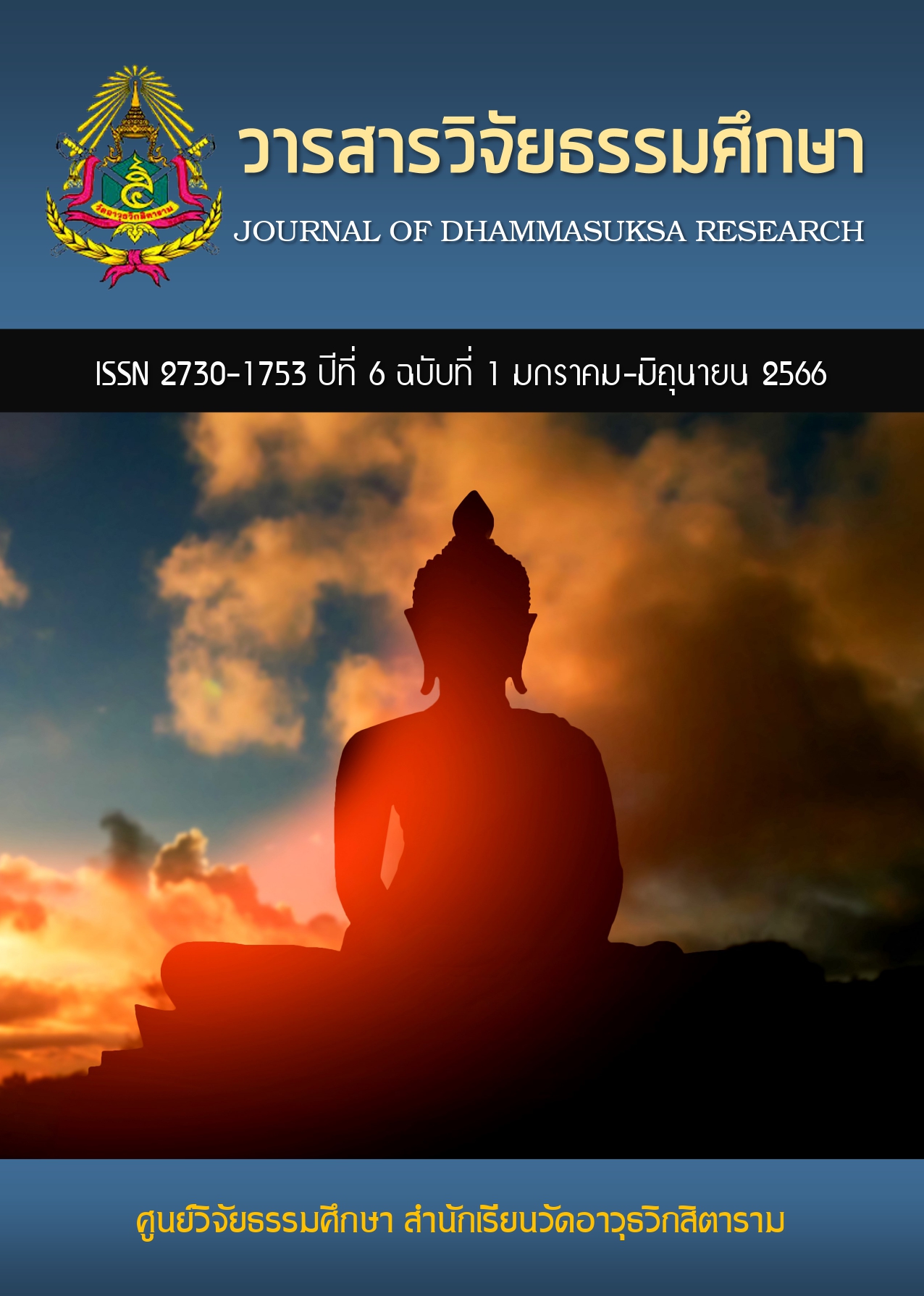นวัตกรรมและเทคโนโลยีการศึกษาเชิงพุทธ
คำสำคัญ:
การศึกษา, เชิงพุทธ, นวัตกรรมและเทคโนโลยีบทคัดย่อ
นวัตกรรมและเทคโนโลยีการศึกษาเชิงพุทธ ถือเป็นวิธีการเรียนการสอนแนวใหม่ที่เป็นเลิศ เป็นการเชื่อมโยงองค์ความรู้ด้านศาสนาเพื่อบูรณาการเข้ากับนวัตกรรม เพื่อให้รู้จักวิธีการเรียนรู้ด้วยตนเอง โดยเริ่มจากทุกข์ สาเหตุให้เกิดทุกข์ วิธีการดับทุกข์ และแนวทางปฏิบัติให้พ้นทุกข์ของตนเอง โดยพระพุทธเจ้าทรงสอนให้ตระหนักถึงคุณค่าของการเรียนรู้โดยผ่านการปฏิบัติ การสนทนา โดยผ่านสื่อ ธรรมชาติ สอนให้เข้าใจง่าย ชวนให้ผู้เรียนใคร่อยากเรียนรู้และปฏิบัติตามด้วยตนเอง สร้างศรัทธา และพอใจในการเรียนรู้ นี้คือนวัตกรรมการสอนที่เป็นเลิศของพระพุทธเจ้า
บทความนี้ได้นำเสนอนวัตกรรมและเทคโนโลยีการศึกษาเชิงพุทธ ที่เกี่ยวข้องกับวิวัฒนาการของการศึกษาแนวพุทธ นวัตกรรมแห่งการเรียนรู้เชิงพุทธ และการเรียนรู้เชิงพุทธ บูรณาการ ซึ่งการเรียนรู้นี้เป็นการสอนที่ดี ทันสมัย และมีวิธีการสอนรูปแบบต่างๆ ที่จัดว่าเป็นนวัตกรรมแบบใหม่ๆ หากเหมาะสมบุคคล แต่ละคน เช่น รูปแบบสากัจฉา หรือสนทนา แบบบรรยาย และแบบตอบปัญหา และทรงสอนแบบเปรียบเทียบ เป็นต้น หลักการที่กล่าวมานั้น พระพุทธองค์ทรงสอนให้ผู้เรียนหรือผู้ฟังธรรมมีส่วนร่วมในการซักถามข้อสงสัยในหลักคำสอนเมื่อเข้าใจแล้ว พระพุทธองค์ก็ทรงให้ผู้เรียนลงมือทำด้วยตนเอง (Learning by Doing) จะได้เกิดการเรียนรู้เข้าใจจากการปฏิบัติด้วยตนเองหรือจากประสบการณ์ จนผู้ปฏิบัติเข้าถึงหลักความจริงด้วยปัญญาของตน และสามารถนำไปปรับใช้ได้อย่างมีคุณภาพต่อไป
เอกสารอ้างอิง
กระทรวงศึกษาธิการ. (2553). พระราชบัญญัติการศึกษาแห่งชาติ พ.ศ. 2542 และที่แก้ไขเพิ่มเติม (ฉบับที่ 2) พ.ศ. 2545 และ (ฉบับที่ 3) พ.ศ. 2553. กรุงเทพฯ: โรงพิมพ์องคก์ารรับส่งสินค้าและพัสดุภัณฑ์.
ชัยวัฒน์ สุทธิรัตน์. (2559). 80 นวัตกรรมการจัดการเรียนรู้ที่เน้นผู้เรียนเป็นสำคัญ. พิมพ์ครั้งที่ 7. นนทบุรี: พีบาลาซ์ดีไชด์แอนปริ้นติ้ง.
พระมหาอุดร อุตฺตโร (มากดี). (2565). นวัตกรรมและเทคโนโลยีสารสนเทศทางการศึกษา. พระนครศรีอยุธยา: มหาวิทยาลัยมหาจุฬาลงกรราชวิทยาลัย.
พิมพ์พรรณ เทพสุเมธานนท์ และคณะ. (2544). หลักการศึกษา. กรุงเทพฯ: มหาวิทยาลัยรามคำแหง.
วิญาดา ลลิตธนภัทร. พุทธวิธีการจัดการศึกษาโดยครอบครัว. วารสาร มจร พุทธปัญญาปริทรรศน์. ปีที่ 2 ฉบับที่ 3 (กันยายน - ธันวาคม 2560).
สำนักวิชาการและมาตรฐานการศึกษา สำนักงานคณะกรรมการการศึกษาขั้นพื้นฐาน. (2552). ตัวชี้วัดและสาระการเรียนรู้ สังคมศึกษา ศาสนา และวัฒนธรรมตามหลักสูตรแกนกลางการศึกษาขั้นพื้นฐานพุทธศักราช 2551. กรุงเทพฯ: โรงพิมพ์ชุมนุมสหกรณ์การเกษตรแห่งประเทศไทย จำกัด.
อมรรัตน์ จินดา และเอกนฤน บางท่าไม้. (มกราคม-เมษายน 2559). สภาพปัญหาและแนวทางส่งเสริมการใช้เทคโนโลยีสารสนเทศและการสื่อสาร เพื่อการศึกษาสาหรับสถานศึกษาในสังกัดสำนักงานเขตพื้นที่การศึกษาประถมศึกษานครปฐม เขต 2. ฉบับภาษาไทยสาขา มนุษยศาสตร์สังคมศาสตร์และศิลปะ, 9 (1).
Mahachulalongkornrajavidyalaya University. (1996). Thai Tipitaka. Bangkok: MCU Press.
ไฟล์ประกอบ
เผยแพร่แล้ว
รูปแบบการอ้างอิง
ฉบับ
ประเภทบทความ
หมวดหมู่
สัญญาอนุญาต
ลิขสิทธิ์ (c) 2023 วารสารวิจัยธรรมศึกษา

อนุญาตภายใต้เงื่อนไข Creative Commons Attribution-NonCommercial-NoDerivatives 4.0 International License.


